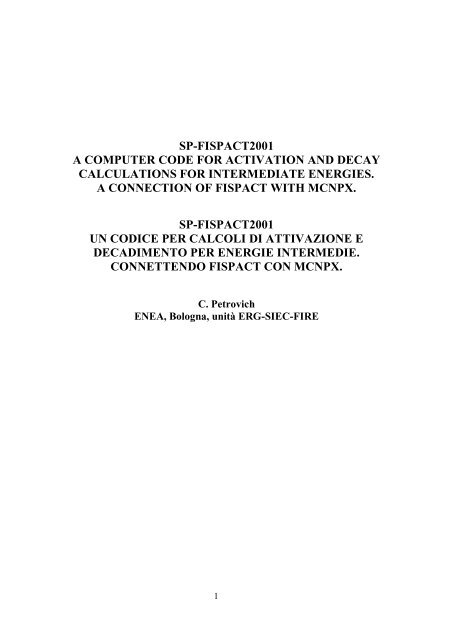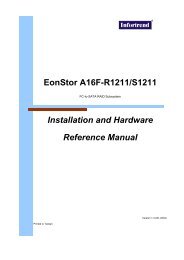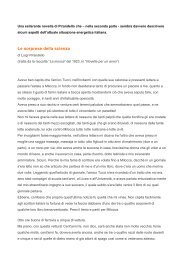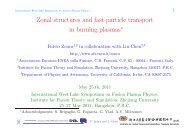You also want an ePaper? Increase the reach of your titles
YUMPU automatically turns print PDFs into web optimized ePapers that Google loves.
SP-FISPACT2001<br />
A COMPUTER CODE FOR ACTIVATION AND DECAY<br />
CALCULATIONS FOR INTERMEDIATE ENERGIES.<br />
A CONNECTION OF FISPACT WITH MCNPX.<br />
SP-FISPACT2001<br />
UN CODICE PER CALCOLI DI ATTIVAZIONE E<br />
DECADIMENTO PER ENERGIE INTERMEDIE.<br />
CONNETTENDO FISPACT CON MCNPX.<br />
C. Petrovich<br />
<strong>ENEA</strong>, Bologna, unità ERG-SIEC-FIRE<br />
1
ABSTRACT<br />
The calculation of the number of atoms and the activity of materials following nuclear<br />
interactions at incident energies up to several GeV is necessary in the design of Accelerator<br />
Driven Systems, Radioactive Ion Beam and proton accelerator facilities such as <strong>sp</strong>allation<br />
neutron sources. As well as the radioactivity of the materials, this allows the evaluation of<br />
the formation of active gaseous elements and the assessment of possible corrosion<br />
problems. The particle energies involved here are higher than those used in typical nuclear<br />
reactors and fusion devices for which many codes already exist.<br />
These calculations can be performed by coupling two different computer codes: MCNPX<br />
and SP-FISPACT. MCNPX performs Monte Carlo particle tran<strong>sp</strong>ort up to energies of<br />
several GeV. SP-FISPACT is a modification of FISPACT, a code designed for fusion<br />
applications and able to calculate neutron activation for energies
TABLE OF CONTENTS<br />
1. Introduction ............................................................................... 7<br />
2. Utilization and limitations of SP-FISPACT2001............ ....... 7<br />
3. Calculations with SP-FISPACT2001 ....................................... 9<br />
3.1 Preparation of the outputs of MCNPX .................................................. 9<br />
3.2 Preparation of the preliminary input COLLAPX ................................ 11<br />
3.3 Preparation of the main input ................................................................. 13<br />
4. Warnings .................................................................................... 14<br />
5. Conclusions ................................................................................ 16<br />
APPENDIX A ................................................................................ 17<br />
APPENDIX B ................................................................................. 25<br />
References ...................................................................................... 28<br />
5
1. Introduction<br />
The purpose of this report is to show how to calculate the number of atoms and the activity of<br />
materials following nuclear interactions (at incident energies up to several GeV) by means of<br />
two different computer codes: MCNPX [1] and SP-FISPACT.<br />
These calculations allow the evaluation of the radioactivity of the materials, of the formation<br />
of active gaseous elements as well as the assessment of possible corrosion problems.<br />
This work has been stimulated by projects concerning Accelerator Driven Systems [2] (the<br />
aim being energy production and transmutation of radioactive waste) and Radioactive Ion<br />
Beam facilities [3] and can be applied also to other proton accelerator facilities, such as<br />
<strong>sp</strong>allation neutron sources. In all these systems the particle energies are higher than those used<br />
in typical nuclear reactors and fusion devices (energies up to some GeV instead of energies<br />
under 20MeV) for which many codes already exist.<br />
FISPACT2001 [4] is a code designed for fusion applications and able to calculate activation<br />
caused by neutron fluxes with energies
protons) in a 3-D geometry. Neutron fluxes can thus be calculated and provided as input to<br />
FISPACT for activation calculation for E
SP-FISPACT, together with these cross-sections, stores the „pseudo cross-sections‟ in this file<br />
and, thus, the different utilization of SP-FISPACT with re<strong>sp</strong>ect to FISPACT concerns only<br />
the way the file COLLAPX is prepared by the input file „collapx.i‟.<br />
See APPENDIX A for the detailed modifications to the subroutines of FISPACT2001 and<br />
APPENDIX B for the definition of the „pseudo cross-section‟.<br />
3. Calculations with SP-FISPACT2001<br />
The procedure for carrying out the calculations is shown in the following page and is<br />
explained here step by step.<br />
3.1 Preparation of the outputs of MCNPX<br />
The MCNPX input file requires the following cards :<br />
- „f4:n‟. This card calculates the volumetric neutron flux. Choose one of the energy group<br />
structures of FISPACT2001 (XMAS, VITAMIN-J, TRIPOLI, see [4]) 2 and, using the card<br />
„e4‟, define the energy bins accordingly.<br />
- „histp‟. This card creates the file „histp‟ (it can be quite a lengthy file). This file is postprocessed<br />
by the code 3 HTAPE3X [1] for calculation of residual nuclei per source proton<br />
after interactions >20MeV.<br />
Two output files are needed from HTAPE3X: the first providing the elastic collisions (this<br />
output file must be called „elast‟), the second providing the residual nuclei after elastic<br />
and inelastic collisions above 20MeV (this ouput file must be called „resid‟):<br />
1. htape3x int=int1 outt=elast<br />
(„int1‟ is the input file for HTAPE3X with the options IOPT=115 and KOPT=2. „elast‟ is the<br />
output containing the elastic collisions).<br />
Here is an example for int1:<br />
Elastic collision<br />
in 25 cells<br />
115,,,,2,25,,,,/<br />
15,20,25,30,44,46,48,52,54,56,58,60,62,64,92,94,96,98,104,<br />
106,108,110,112,114,116<br />
2 The group structures GAM-II and WIMS are not suitable since their highest energy values are re<strong>sp</strong>ectively 14.9<br />
MeV and 10 MeV.<br />
3 This code belongs to the MCNPX package.<br />
9
output<br />
(with flux
2. htape3x int=int2 outt=resid<br />
(„int2‟ is the input file for HTAPE3X with the options IOPT=108 and KOPT=0. „resid‟ is the<br />
output containing the residual nuclei).<br />
Here is an example for int2:<br />
Residual nuclei<br />
in 25 cells<br />
108,,,,0,25,,,,/<br />
15,20,25,30,44,46,48,52,54,56,58,60,62,64,92,94,96,98,104,<br />
106,108,110,112,114,116<br />
Until now this is just a standard MCNPX procedure.<br />
SP-FISPACT2001 will read the values of „resid‟ (stable and metastable isotopes) and subtract<br />
these values from „elast‟ to obtain the residual nuclei per source proton; finally it will create<br />
the preliminary file COLLAPX with the new pseudo cross-sections.<br />
3.2 Preparation of the preliminary input COLLAPX<br />
The file FLUXES for FISPACT needs to be prepared with the values of the flux <strong>sp</strong>ectrum<br />
under 20 MeV as provided by MCNPX.<br />
In order to prepare properly the preliminary input „collapx.i‟ for SP-FISPACT, the user must<br />
<strong>sp</strong>ecify before the code word COLLAPSE: the value of the flux under 20MeV irradiating the<br />
material, the source proton current used, the material irradiated and the number of atoms of<br />
this material. Five new code words have been introduced for this purpose: CURRENT,<br />
TARGET, ATTARGET, HCOLLAPSE, TCOLLAPSE.<br />
The file collapx.i has to be prepared following these steps:<br />
1. Input the integrated flux under 20MeV using the code word FLUX (this is a standard<br />
FISPACT code word, but it has to be <strong>sp</strong>ecified also in the preliminary input and not only in<br />
the main input). If activation calculations are needed only above 20MeV then enter in any<br />
case a value of the flux as well as a <strong>sp</strong>ectrum of the flux in the file FLUXES. These will be<br />
fictitious values without any consequence for the results. Use a realistic value, such as FLUX<br />
1E15 (see WARNINGS n. 5 at page 14).<br />
Example: if there is a flux under 20MeV of 10 14 neutrons/cm 2 sec, then write: FLUX 1E14.<br />
2. Input the proton current (in mA) used as source particles in MCNPX. Since the results in<br />
MCNPX are, as stated above, provided as residual nuclei per source particle, the value of the<br />
current has to be fixed in order to provide the correct number of residual nuclei per second.<br />
The new code word is CURRENT.<br />
Example: if the proton current of the accelerator is 3mA, then write: CURRENT 3.<br />
11
3. Input the main nuclide which composes the material irradiated in the MCNPX problem.<br />
The isotope must be indicated with the ID number as used internally by FISPACT (see [9] or<br />
the file EAF_INDEX_20010 in the directory „eaf2001‟). It is allowed to input only a single<br />
isotope. If the material is composed of more than one isotope then choose the most abundant.<br />
SP-FISPACT2001 will perform calculations as if all the residual nuclei provided by<br />
HTAPE3X were produced by this isotope.<br />
The new code word is TARGET.<br />
Example: if the material irradiated is natural Pb, Pb 208 can be chosen as representative of the<br />
whole material and write TARGET 1631.<br />
4. Input the number of atoms of the isotope chosen in the above paragraph. The new code<br />
word is ATTARGET.<br />
Example: if there are 1E29 atoms of Pb 208 , then write: ATTARGET 1E29.<br />
5. The standard code word NOERROR (see [4], p. 44) must be used because the error data<br />
for the interactions above 20MeV are not present.<br />
6. Specify one of the following two new code words as alternative to the standard code word<br />
COLLAPSE: TCOLLAPSE or HCOLLAPSE.<br />
-TCOLLAPSE stands for „Total Collapse‟. This code word collapses both the standard<br />
FISPACT cross-sections and the pseudo cross-sections >20MeV. All the values are written in<br />
the file COLLAPX.<br />
Example: if the cross section library in 175 groups is to be used, then: TCOLLAPSE 175.<br />
-HCOLLAPSE stands for „High Collapse‟. This code word collapses only the pseudo crosssection<br />
>20MeV created from MCNPX and not the standard FISPACT2001 cross-section.<br />
This option can be used if only the effects of interactions >20MeV are to be investigated.<br />
Example: HCOLLAPSE 175.<br />
Here is an another example of preliminary input file „collapx.i‟ for an accelerator of 30mA,<br />
providing a flux under 20MeV of 3.43E14 neutrons/cm 2 sec in 4.92E25 atoms of 9 Be. The<br />
energy group VITAMIN-J is used under 20MeV.<br />
FLUX 3.43E14<br />
CURRENT 30<br />
TARGET 15<br />
ATTARGET 4.92E25<br />
NOERROR<br />
TCOLLAPSE 175<br />
FISPACT<br />
* COLLAPSE VITAMIN-J<br />
END<br />
* END OF RUN<br />
/*<br />
12
As in the standard FISPACT procedure prepare the preliminary file arrayx.i and run:<br />
<strong>sp</strong>fi<strong>sp</strong>01 collapx.out<br />
<strong>sp</strong>fi<strong>sp</strong>01 arrayx.out<br />
3.3 Preparation of the main input<br />
The main input is a standard FISPACT input with the following constraints:<br />
1. It is necessary to use the code word FUEL (with the DENSITY code word) and not the<br />
code word MASS.<br />
2. The number of atoms of the material irradiated in MCNPX and <strong>sp</strong>ecified in the<br />
preliminary input (code word ATTARGET) has to be provided again with the code word<br />
FUEL (it must obviously have the same value).<br />
3. The value of the flux under 20MeV has to be provided again (it must obviously have the<br />
same value).<br />
Here is an example of the main input for the same example as the previous preliminary input:<br />
AINP<br />
FISPACT<br />
*Residual nuclei at all energies<br />
DENSITY 1.8477<br />
FUEL 1<br />
BE9 4.92E25<br />
MIND 1.0E5<br />
FLUX 3.43E14<br />
ATOMS<br />
LEVEL 100 8<br />
TIME 1 YEARS<br />
ATOMS<br />
FLUX 0.<br />
ZERO<br />
TIME 1 HOURS<br />
ATOMS<br />
END<br />
* END<br />
/*<br />
Finally, run:<br />
<strong>sp</strong>fi<strong>sp</strong>01 output<br />
13
4. Warnings<br />
1. Not all the nuclides provided by MCNPX are included in the EAF2001 decay data library<br />
[9] (the missing nuclides are usually neutron-rich nuclides for low Z and neutron-deficient<br />
nuclides for high Z). This follows from the fact that residual nuclei are calculated by MCNPX<br />
by means of physics models while those included in EAF2001 are based on experimental<br />
evaluations. These nuclides are expunged by SP-FISPACT2001 and highlighted in the output<br />
of the collapse process (collapx.out). In the cases analysed they represent 20%-45% of the<br />
total number of nuclides and about 1%-25% of the total residual nuclei production. The<br />
greatest number of expunged nuclei are obtained for high energy fission on U 238 where many<br />
exotic nuclei are produced. Their contribution seems negligible in a first approximation for<br />
<strong>sp</strong>allation processes (6%) but, depending on their decay modes, the activity could be more<br />
considerable. Since most of these data are publicly available (see [10]), the nuclide inventory<br />
in the EAF2001 decay data library could be increased for this purpose.<br />
2. The production of gas nuclides (H 1 , H 2 , H 3 , He 3 , He 4 ) as a consequence of the nuclear<br />
interactions above 20MeV has not yet been implemented.<br />
3. The production of daughter nuclides is proportional to the number of atoms of the parent<br />
nuclides (see equation (1) in APPENDIX B). Therefore, the decrease with time of the amount<br />
of atoms of the initial material causes a decrease in the production of residual nuclei above<br />
20MeV (see the factor Nj(t)/Nj(0) in APPENDIX B). This should be treated as a burn-up<br />
effect but it is usually negligible even for long period of irradiation (Nj(t)/Nj(0) decreases by<br />
0.5% in value for typical cases). The user should check and evaluate the effect for the<br />
problem under investigation.<br />
4. Even if the material irradiated in MCNPX is composed of more than one isotope only a<br />
single isotope must be chosen in SP-FISPACT2001. This does not affect the residual nuclei<br />
production, but the decrease in time of the number of atoms of the initial material turns out to<br />
be approximated. As mentioned above, this effect is usually negligible (although in principle<br />
all the quantities involving the weight of the material irradiated, such as the DOSE RATE, are<br />
thus modified).<br />
5. The pseudo cross-sections created in the file COLLAPX must have a value higher than<br />
~10 -20 (see equation (3), APPENDIX B). Lower values (they should not occur with usual<br />
physical problems) give rise to errors due to the fact that the arrays are treated as single<br />
precision variables. The user is re<strong>sp</strong>onsible for checking such values.<br />
6. The activity and particle emission (�, �, �) due to the formation of the residual nuclei<br />
described by the physics models (such as residual deexcitation processes) is not included in<br />
the treatment; the duration in time of the whole nuclear interaction process has been<br />
neglected.<br />
7. In the FISPACT main output the values „FLUX‟ and „FLUENCE‟ refer to the values<br />
under 20MeV provided by the user. The values „NUMBER OF FISSION‟ and „HEAT<br />
PRODUCTION‟ and the particle emissions do not include fissions over 20MeV.<br />
8. All the code words concerning uncertainties (such as UNCERTAINTY) are not available.<br />
Also pathway analysis is not a possible option.<br />
9. The highest value of the energy used by FISPACT is 19.64 MeV and the lowest neutron<br />
energy value considered in HTAPE3X is 20MeV. Thus the bin 19.64-20MeV is neglected.<br />
14
10. Benchmarks of MCNPX (physics models at 1GeV) suggest to consider roughly the<br />
degree of accuracy in predicting residual nuclei as a factor of 2 for <strong>sp</strong>allation events and as a<br />
factor of 10 for fission events [6]. This is a general trend, individual isotopes can be<br />
mi<strong>sp</strong>redicted even by 2 orders of magnitude. In the range ~20-100MeV the accuracy of the<br />
models is generally worse than above ~100 MeV.<br />
11. FISPACT can treat only trace amounts of actinides that are able to fission because selfshielding<br />
and burn-up effects are not included (see [4], p.11)<br />
15
5. Conclusions<br />
SP-FISPACT2001 makes possible the calculation of the number of atoms and the activity of<br />
materials following nuclear interactions at energies up to several GeV (for energies
APPENDIX A – Fortran Modifications to FISPACT2001<br />
Only one subroutine has been added to FISPACT2001. The subroutine is called <strong>sp</strong>all.f. The<br />
other modifications to the original code only concern the following subroutines:<br />
fmain.f<br />
col069.f<br />
col100.f<br />
col172.f<br />
col175.f<br />
col315.f<br />
The subroutine fmain.f has been modified in order to add five new code words: CURRENT,<br />
TARGET, ATTARGET, HCOLLAPSE, TCOLLAPSE. All of them concern the<br />
preliminary input.<br />
In FISPACT2001 the subroutines col*.f are called by fmain.f (code word COLLAPSE) in<br />
order to create the file COLLAPX according to the desired energy group structure. The<br />
subroutine <strong>sp</strong>all.f is called by the subroutines col*.f (code words TCOLLAPSE and<br />
HCOLLAPSE) for calculations of the pseudo cross-sections for interactions over 20MeV.<br />
Subroutine <strong>sp</strong>all.f<br />
SUBROUTINE SPALL<br />
C C.Petrovich - <strong>ENEA</strong><br />
C***************************************************************<br />
C SUBROUTINE FOR CALCULATIONS >20MeV.<br />
C IT USES OUTPUTS PRODUCED BY MCNPX 2.1.5 AND HTAPE3X<br />
C***************************************************************<br />
C<br />
CHARACTER*80 FILES<br />
COMMON /FILES1/ FILES(40)<br />
COMMON /SPAL1/ CPFLUX,CURR,IDTARG,ATTARG<br />
COMMON /SPAL3/ NP2(15000),ND2(15000),ZSEKT(15000),MCP2<br />
DOUBLE PRECISION HISOT(0:300,0:300),ELAS(0:300,0:300),EL,HIS,<br />
* HISOTM(0:300,0:300)<br />
PARAMETER (IS=3000)<br />
INTEGER IZ(IS),IN(IS),IA(IS),IZE(IS),INE(IS),<br />
* IZF(IS),INF(IS),IAF(IS),IZM(IS),INM(IS),IAM(IS),<br />
* ID(IS),IDF(0:300,0:300),IDFM(0:300,0:300)<br />
CHARACTER B*6,C*5,D*3<br />
c Protons per second in 1mA<br />
PROTSC=6.24146E15<br />
17
c Initialisation<br />
NUCLF=0<br />
NUCLH=0<br />
NMET=0<br />
EL=0<br />
HIS=0<br />
PERCF=0<br />
PERCN=0<br />
TOTH=0<br />
TOTF=0<br />
DO 5, I=1,IS<br />
IZ(I)=0<br />
IN(I)=0<br />
IA(I)=0<br />
IZE(I)=0<br />
INE(I)=0<br />
IZF(I)=0<br />
INF(I)=0<br />
IAF(I)=0<br />
IZM(I)=0<br />
INM(I)=0<br />
IAM(I)=0<br />
ID(I)=0<br />
5 CONTINUE<br />
DO 11,I=1,300<br />
DO 10,J=1,300<br />
HISOT(I,J)=0<br />
HISOTM(I,J)=0<br />
ELAS(I,J)=0<br />
IDF(I,J)=0<br />
IDFM(I,J)=0<br />
10 CONTINUE<br />
11 CONTINUE<br />
C<br />
C Read elastic collisions from 'elast' (HTAPE3X output).<br />
C 'mean ' points the end of the file<br />
C<br />
OPEN(1,FILE='elast',STATUS='OLD',FORM='FORMATTED')<br />
DO 25, I=1,IS<br />
READ(1,15) C,D<br />
15 FORMAT(5X,A5,3X,A3)<br />
IF (C.EQ.'mean ') GOTO 30<br />
IF (D.EQ.'n =') THEN<br />
BACKSPACE 1<br />
18
READ(1,20) IZE(I),INE(I),EL<br />
20 FORMAT(8X,I3,6X,I3,3X,D11.5)<br />
IF (IZE(I).EQ.0) IZE(I)=IZE(I-1)<br />
ELAS(IZE(I),INE(I))=EL<br />
END IF<br />
25 CONTINUE<br />
C<br />
C Read residual nuclei (with elastic collisions)<br />
C from 'resid' (HTAPE3X output).<br />
C Then elastic collisions are subtracted.<br />
C 'all z' points the end of the file.<br />
C TOTH: sum of residual nuclei per source particle<br />
C NUCLH: total number of nuclides<br />
C<br />
30 OPEN(2,FILE='resid',STATUS='OLD',FORM='FORMATTED')<br />
DO 35, I=1,IS<br />
READ(2,15) C,D<br />
IF (C.EQ.'all z') GOTO 40<br />
IF (D.EQ.'n =') THEN<br />
BACKSPACE 2<br />
READ(2,20) IZ(I),IN(I),HIS<br />
IF (IZ(I).EQ.0) IZ(I)=IZ(I-1)<br />
IA(I)=IN(I)+IZ(I)<br />
HISOT(IZ(I),IN(I))=HIS-ELAS(IZ(I),IN(I))<br />
TOTH=TOTH+HISOT(IZ(I),IN(I))<br />
IF (HISOT(IZ(I),IN(I)).GT.0) NUCLH=NUCLH+1<br />
ENDIF<br />
35 CONTINUE<br />
C<br />
C Read metastable nuclides from 'resid'<br />
C NMET: Number of metastable nuclides<br />
C which are not only metastable<br />
C<br />
40 READ(2,42) B<br />
42 FORMAT(11X,A6)<br />
IF (B.EQ.'metast') THEN<br />
READ(2,'(/)')<br />
DO 48, I=1,IS<br />
READ(2,45) IZM(I),IAM(I),FRACM<br />
45 FORMAT(2X,I3,2X,I3,27X,D11.5)<br />
IF (IZM(I).EQ.0) GOTO 50<br />
IF (.NOT.FRACM.EQ.1) NMET=NMET+1<br />
INM(I)=IAM(I)-IZM(I)<br />
HISOTM(IZM(I),INM(I))=HISOT(IZM(I),INM(I))*FRACM<br />
19
HISOT(IZM(I),INM(I))=HISOT(IZM(I),INM(I))*(1-FRACM)<br />
48 CONTINUE<br />
ENDIF<br />
GOTO 40<br />
C<br />
C Read nuclides from 'EAF_INDEX_20010' (FISPACT2001)<br />
C to identify material numbers of the nuclides<br />
C provided by HTAPE3X.<br />
C Z,N nuclides are recorded in IDF(Z,N)<br />
C Metastable recorded in IDFM(Z,N)<br />
C<br />
50 OPEN(18,FILE=FILES(18),STATUS='UNKNOWN',IOSTAT=IOS)<br />
DO 55, J=1,1922<br />
READ(18,52,END=60) ID(J),IZF(J),IAF(J),M<br />
52 FORMAT (2X,I4,9X,I3,I3,I1)<br />
INF(J)=IAF(J)-IZF(J)<br />
IF (M.EQ.0) IDF(IZF(J),INF(J))=ID(J)<br />
IF (M.EQ.1) IDFM(IZF(J),INF(J))=ID(J)<br />
55 CONTINUE<br />
C<br />
C Record the pseudo-cross-sections in NP2,ND2,ZSEKT<br />
C (variables used for 'COLLAPX').<br />
C MCP2 and NUCLF count the number of lines<br />
C (nuclides of 'resid' also present<br />
C in the file 'EAF_INDEX_20010' of FISPACT2001).<br />
C The expunged nuclides are written in collapx.out.<br />
C TOTF: Total residual nuclei also present in FISPACT.<br />
C<br />
60 WRITE (6,65)<br />
65 FORMAT (/,' WARNING. The following nuclides produced by HTAPE3X ',<br />
*'have not been accepted by FISPACT2001',/,/,11X,'Z A',/)<br />
DO 80, I=1,IS<br />
IF (HISOT(IZ(I),IN(I)).EQ.0) GOTO 75<br />
IF (IDF(IZ(I),IN(I)).EQ.0) THEN<br />
WRITE(6,70) IZ(I),IA(I)<br />
70 FORMAT (8X,I4,1X,I4)<br />
GOTO 75<br />
ELSE<br />
NUCLF=NUCLF+1<br />
MCP2=MCP2+1<br />
TOTF=TOTF+HISOT(IZ(I),IN(I))<br />
NP2(MCP2)=IDTARG<br />
ND2(MCP2)=IDF(IZ(I),IN(I))<br />
ZSEKT(MCP2)=HISOT(IZ(I),IN(I))*PROTSC*CURR/(ATTARG*CPFLUX)<br />
20
GOTO 75<br />
ENDIF<br />
C Same for metastable nuclides<br />
75 IF (HISOTM(IZ(I),IN(I)).EQ.0) GOTO 80<br />
IF (IDFM(IZ(I),IN(I)).EQ.0) THEN<br />
WRITE(6,77) IZ(I),IA(I)<br />
77 FORMAT (8X,I4,1X,I4,'m')<br />
GOTO 80<br />
ELSE<br />
NUCLF=NUCLF+1<br />
MCP2=MCP2+1<br />
TOTF=TOTF+HISOTM(IZ(I),IN(I))<br />
NP2(MCP2)=IDTARG<br />
ND2(MCP2)=IDFM(IZ(I),IN(I))<br />
ZSEKT(MCP2)=HISOTM(IZ(I),IN(I))*PROTSC*CURR/(ATTARG*CPFLUX)<br />
ENDIF<br />
80 CONTINUE<br />
C<br />
C Adds metastable nuclides (NMET) to the number of nuclides (NUCLH).<br />
C Writes out how many nuclides have been expunged by FISPACT.<br />
C<br />
NUCLH=NUCLH+NMET<br />
NUCLF=NUCLH-NUCLF<br />
TOTF=TOTH-TOTF<br />
PERCN=100*(REAL(NUCLF)/REAL(NUCLH))<br />
PERCR=100*(TOTF/TOTH)<br />
WRITE(6,90) NUCLF,NUCLH,PERCN<br />
90 FORMAT(/,1X,'FISPACT2001 has not accepted ',I4,1X,<br />
*'nuclides out of ',I4,' nuclides produced by HTAPE3X (',<br />
*0PF7.3,'%)')<br />
WRITE(6,95) TOTF,TOTH,PERCR<br />
95 FORMAT(1X,'These corre<strong>sp</strong>ond to ',1PE10.4,<br />
*' residual nuclei per source particle out of ',<br />
*1PE10.4,' (',0PF7.3,'%)',/)<br />
c<br />
RETURN<br />
END<br />
21
The differences between the two fmain.f subroutines are the following (the line numbers are<br />
indicated):<br />
332a333,340<br />
> c<br />
> c begin >20MeV C.Petrovich<br />
> c<br />
> COMMON /SPAL1 /CPFLUX,CURR,IDTARG,ATTARG<br />
> COMMON /SPAL2 /FLAGCP<br />
> c<br />
> c end >20MeV C.Petrovich<br />
> c<br />
755c763,767<br />
< +*SEQU*GRPC*EAFV*PULS*ENDP*FISY*UNCT*NEWF*CLEA*SPLI&',4)<br />
---<br />
><br />
+*SEQU*GRPC*EAFV*PULS*ENDP*FISY*UNCT*NEWF*CURR*TARG*ATTA*TCO<br />
L*HCOL*<br />
> +CLEA*SPLI&',4)<br />
> c<br />
> c 20 MeV C.Petrovich. Added in the previous line:<br />
> c *CURR*TARG*ATTA*TCOL*HCOL<br />
775c787,791<br />
< * 1170,1180),J<br />
---<br />
> * 1175,1177,1185,1190,1195,1170,1180),J<br />
> c<br />
> c 20 MeV C.Petrovich. Added in the previous line:<br />
> c 1175,1177,1185,1190,1195,<br />
> c<br />
776a793<br />
> C<br />
1052a1070,1076<br />
> c<br />
> c begin >20MeV C.Petrovich<br />
> c<br />
> CPFLUX=FLUX2<br />
> c<br />
> c end >20MeV C.Petrovich<br />
> c<br />
2403a2428,2456<br />
> c<br />
> c begin >20MeV C.Petrovich<br />
22
c New code words to be input in the preliminary input for collapsing<br />
> c ..........................................................CURR......<br />
> c proton current<br />
> 1175 ICHK=NEWDEC(1)<br />
> CURR=FLDEC(0)<br />
> GO TO 100<br />
> c ..........................................................TARG.....<br />
> c material number<br />
> 1177 ICHK=NEWDEC(1)<br />
> IDTARG=INDEC(0)<br />
> GO TO 100<br />
> c ........................................................ATTARGET...<br />
> c number of atoms of the material number TARG<br />
> 1185 ICHK=NEWDEC(1)<br />
> ATTARG=FLDEC(0)/1E24<br />
> GO TO 100<br />
> c .........................................total collapse...TCOL.....<br />
> c FLAG for collapsing all energies<br />
> 1190 FLAGCP=1<br />
> GO TO 410<br />
> c ..........................................high collapse....HCOL...<br />
> c FLAG for collapsing only interactions >20MeV<br />
> 1195 FLAGCP=2<br />
> GO TO 410<br />
> c<br />
> c end >20MeV C.Petrovich<br />
Since the modifications to the subroutines col*.f are very similar, only the modifications to<br />
the subroutine col175.f are shown.<br />
29,31c29,41<br />
< DIMENSION NUCL(1950),FLUX(176),XSECT(176),ZSECT(24000),<br />
< + ZSEKT(15000),MREAC(114),NP(24000),ND(24000),<br />
< + NP2(15000),ND2(15000),JPAR(1000)<br />
---<br />
> c<br />
> c begin >20MeV C. Petrovich<br />
> c<br />
> c before: DIMENSION NUCL(1950),FLUX(176),XSECT(176),ZSECT(24000),<br />
> c + ZSEKT(15000),MREAC(114),NP(24000),ND(24000),<br />
> c + NP2(15000),ND2(15000),JPAR(1000)<br />
> DIMENSION NUCL(1950),FLUX(176),XSECT(176),ZSECT(24000),<br />
> + MREAC(114),NP(24000),ND(24000),JPAR(1000)<br />
23
COMMON /SPAL3/ NP2(15000),ND2(15000),ZSEKT(15000),MCP2<br />
> COMMON /SPAL2/ FLAGCP<br />
> c<br />
> c end >20MeV C. Petrovich<br />
> c<br />
792a803,815<br />
> c<br />
> c begin >20MeV C. Petrovich<br />
> c FLAGCP>0 for collapsing >20MeV<br />
> c FLAGCP=2 not collapsing IF (FLAGCP.GT.0) THEN<br />
> IF (FLAGCP.EQ.2) M=0<br />
> MCP2=M<br />
> CALL SPALL<br />
> M=MCP2<br />
> ENDIF<br />
> c<br />
> c end >20MeV C. Petrovich<br />
> c<br />
24
APPENDIX B – Definition of ‘pseudo cross-sections’<br />
The number of atoms Ni of the nuclide i produced by the stable nuclide j is governed by the<br />
following equation (without considering fission) 4 :<br />
where:<br />
� is the neutron flux (n cm -2 s -1 )<br />
Nj(t) is the amount of nuclide j at time t<br />
�ij is the reaction cross section for reactions on j producing i (barns).<br />
If there is a fixed number of source particles per second (such as protons in an accelerator)<br />
causing an amount Ni of residual nuclei to be formed in a given material, then the production<br />
of Ni (without decays) is ruled by:<br />
dNi<br />
( t)<br />
dt<br />
where:<br />
„Residual nuclei Ni per source proton‟ is provided by the code HTAPE3X.<br />
The number of „Source protons per sec‟ depends on the current used in the accelerator.<br />
This is the contribution coming from interactions >20MeV to be added in FISPACT2001.<br />
We can define a pseudo cross-section (a fictitious cross-section) such that:<br />
Residual nuclei N<br />
� �<br />
ij<br />
dNi<br />
t)<br />
� ��<br />
ij N j ( t)<br />
�10<br />
dt<br />
( �24<br />
� Residual nuclei N<br />
where:<br />
� is the integral neutron flux under 20MeV (n cm -2 s -1 ).<br />
Nj(0) is the number of atoms of the nuclide j forming the nuclide i at time t=0.<br />
In this way FISPACT will calculate:<br />
4 The complete equation can be found in [4], page 90.<br />
i<br />
i<br />
per source proton * Source protons per sec<br />
per source proton*<br />
Source protons per sec*<br />
10<br />
� * N ( 0)<br />
j<br />
25<br />
(1)<br />
24<br />
(2)<br />
(3)
dNi<br />
( t)<br />
�24<br />
� ��<br />
ij N j ( t)<br />
�10<br />
�<br />
dt<br />
= Residual nuclei Ni per source proton * Source protons per sec * Nj(t)/Nj(0).<br />
If the number of atoms of the initial material remains approximately constant (this is true in<br />
most cases, but the re<strong>sp</strong>onsibility for checking that is left to the user), then Nj(t)/Nj(0)�1 and<br />
we obtain the desired equation (2).<br />
26
Acknowledgements<br />
K.W. Burn provided fruitful discussions.<br />
Disclaimer<br />
Neither the author nor <strong>ENEA</strong> accept re<strong>sp</strong>onsibility for consequences arising from errors in the<br />
present report.<br />
Contact person<br />
Feedback on the use of SP-FISPACT2001 is welcomed. Please contact the author with<br />
comments.<br />
Carlo Petrovich<br />
<strong>ENEA</strong><br />
Via M.M.Sole 4, Bologna 40129<br />
Tel. +39-051-6098517<br />
E-mail: carlop@bologna.enea.it<br />
27
References<br />
[1] Laurie S. Waters, Editor: „MCNPX TM User’s Manual‟, Version 2.1.5, TPO-E83-G-UG-X-<br />
00001, November 14, 1999 (http://mcnpx.lanl.gov/).<br />
[2] C. Rubbia, J.A. Rubio, S. Buono, F.Carminati , N. Fieter, J. Galvez, C. Gelel, Y. Kadi, R.<br />
Klapisch, P. Mandrillon, J.P. Revol and Ch. Roche, „Conceptual Design of a Fast Neutron<br />
Operated High Power Energy Amplifier‟, CERN/AT/95-44(ET).<br />
[3] „SPES, Project Study of an Advanced Facility For Exotic Beams at LNL‟, LNL-INFN<br />
(REP) 145/99, June 1999.<br />
[4] RA Forrest and J-Ch Sublet, „FISPACT-2001: User manual‟, EURATOM/UKAEA<br />
Fusion Association, Culham Science Centre, Abingdon, Oxfordshire OX14 3DB, UK, March<br />
2001 (http://www.fusion.org.uk/easy2001/).<br />
[5] J. F. Briesmeister, editor, ‘MCNP TM - A General Monte Carlo N-Particle Tran<strong>sp</strong>ort Code’,<br />
Los Alamos National Laboratory, LA-12625-M (March 1997).<br />
(http://www-xdiv.lanl.gov/XCI/PROJECTS/MCNP/manual.html).<br />
[6] Yury E. Titarenko et al., Fission Products Yields in Hybrid (ADS) Target Materials<br />
induced by High-Energy Proton, Proc. of the 15 th Int. Workshop on Fission Physics, Obninsk,<br />
Russia, October 2-6, 2000. LA-UR-00-5848.<br />
[7] Yu. N. Shubin , V.P. Lunev, A. Yu. Konobeyev, A.I. Ditjuk, ‘Cross-section data library<br />
MENDL-2 to study activation as trasmutation of materials irradiated by nucleons of<br />
intermediate energies’. report INDC(CCP)-385 (IAEA, May 1995).<br />
[8] Yu.A. Korovin, A.Yu. Konobeyev, P.E. Pereslavtsev, A.Yu. Stankovsky, C. Broeders, I.<br />
Broeders, U. Fischer, U. von Möllendorff, „Evaluated nuclear data files for accelerator<br />
driven systems and other intermediate and high-energy applications’, Nuclear Instr. and<br />
Methods in Physics Research A 463 (2001) p.544-556.<br />
[9] RA Forrest, „The European Activation File: EAF-2001 decay data library‟, UKAEA FUS<br />
452, UK, March 2001.<br />
[10] The Berkeley Laboratory Isotopes Project's, Ernest O. Lawrence Berkeley National<br />
Laboratory, (http://ie.lbl.gov/education/isotopes.htm).<br />
28







